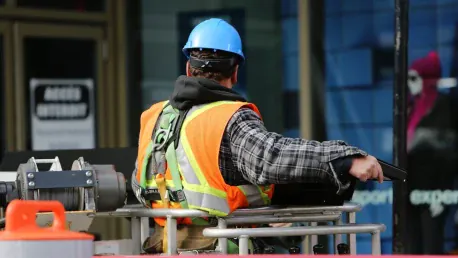The construction sector is undergoing substantial transformations, driven by economic shifts, increased project complexity, and a growing emphasis on sustainability. David Bowcott, Executive Vice President of Platform Insurance, provides insights into how these factors are influencing the sector and how insurance providers are adapting to meet new demands. As economic conditions evolve and the nature of construction projects changes, risks are shifting, necessitating new insurance models to better manage these emerging challenges.
Economic Shifts and Market Segmentation
The construction market is experiencing varied impacts across different segments due to multiple economic shifts. For instance, rising interest rates have caused a notable slowdown in residential construction, while the commercial real estate sector has cooled because more people are working from home. On the other hand, the renewables sector is booming, driven by the increasing demand for clean energy solutions. At the same time, onshore manufacturing is seeing a resurgence as companies aim to mitigate supply chain vulnerabilities by bringing production closer to home. This shift is evident in the increased number of projects like battery plants, chip plants, and data centers.
Despite these changes, challenges persist, particularly in infrastructure. Bowcott notes a slowdown in infrastructure projects but remains optimistic about the overall construction activity. He emphasizes that governments often use infrastructure spending as an economic stimulus during downturns, leading to fluctuations in construction activity. This cyclical nature of infrastructure investment underscores the need for adaptable and resilient insurance models that can keep pace with these shifts.
Increasing Project Complexity and New Delivery Models
Construction projects are becoming larger and more complex, necessitating a shift from traditional delivery models. The design-bid-build model is increasingly being replaced by the design-build model, which introduces higher risks of cost overruns due to bidding on incomplete designs. This shift has led to a greater reliance on insurance as a risk mitigation tool. To address these risks, project owners are exploring new procurement models such as design-assist, progressive design-build, and integrated project delivery. These models require more upfront planning and early contractor involvement, promising better cost accuracy and fewer surprises during the project lifecycle.
However, deficient planning remains a critical issue, especially in mega projects. These large-scale projects often suffer from inadequate initial designs, resulting in significant cost overruns and delays. Bowcott points to research from Oxford University, which tracks data on 16,000 mega projects and illustrates a persistent pattern of cost overruns and delays. This deficit in planning can lead to a myriad of issues on the job site, including various claims for property, casualty, and professional liability. The increased complexity of projects demands more sophisticated insurance solutions to cover the varied risks involved.
The Role of Insurance in Mitigating Risks
Given the growing complexity of construction projects, the role of insurance is increasingly vital. Smaller projects might only require basic property insurance or a project-specific builder’s risk policy. In contrast, mid-sized and large projects often necessitate a broader spectrum of coverages, including wrap-up liability, professional liability, and environmental insurance. The prevalent practice of subcontracting, where up to 95% of work is outsourced, has led to the growing use of subcontractor default insurance. However, insurance capacity, particularly for professional liability, is stressed. Projects that ideally should have $100 million in coverage may only secure $25 million, leaving stakeholders financially vulnerable.
Stakeholders are often left to rely on their balance sheets to cover gaps when ideal insurance coverage is unavailable. This shortfall in coverage can result in significant financial strain, especially on larger projects with higher risk profiles. The evolving risk landscape demands that insurance providers adapt their models to accommodate these burgeoning complexities and new requirements. By investing in new capabilities and more robust insurance frameworks, providers can better support the changing needs of the construction sector.
Sustainability and Environmental Considerations
Sustainability is a significant factor reshaping the construction industry. With the imperative to reduce its carbon footprint, the sector is adopting new technologies aimed at mitigating environmental impacts. This includes exploring sustainable materials and integrating Environmental, Social, and Governance (ESG) policies into operations. Contractors are striving to diminish their carbon footprints through the use of sustainable practices, though the transition poses challenges. One significant hurdle is the industry’s heavy reliance on cement, which is a major carbon emitter.
Bowcott highlights the Netherlands, where procurement models now incorporate carbon emissions costs alongside construction costs, showcasing a shift toward more environmentally responsible practices. However, the lack of viable alternatives to traditional materials remains a significant challenge. Scaling up new technologies to make a substantial impact on sustainability is difficult in an industry entrenched in long-established practices. Despite these challenges, the push towards sustainability is undeniable and requires continued adaptation and innovation from both contractors and insurance providers.
Adapting Insurance Models to New Realities
The construction industry is experiencing significant changes, driven by economic fluctuations, increasing project complexity, and a stronger focus on sustainability. David Bowcott, Executive Vice President of Platform Insurance, sheds light on how these dynamics are reshaping the sector and how insurance companies are evolving to address new demands. With economic conditions shifting and the nature of construction projects becoming more intricate, the associated risks are also transforming. This evolution necessitates the development of new insurance models to effectively manage these emerging risks.
As construction projects grow in complexity, they face heightened uncertainties and potential setbacks. Sustainability concerns are also leading to new building practices, which introduce additional layers of risk. To stay ahead in this rapidly changing environment, insurance providers must innovate, offering tailored solutions that address both traditional risks and those associated with modern, sustainable construction. These adaptations are crucial for ensuring that the industry can thrive amidst these transformative times, protecting both the projects and the stakeholders involved.









